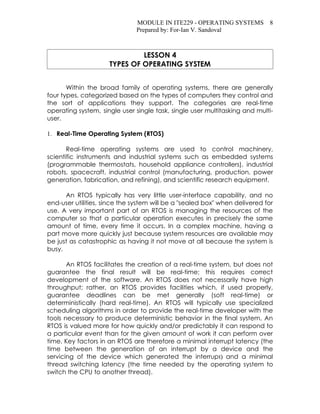
Lesson 4 Types Of Operating Systems
- 1. MODULE IN ITE229 - OPERATING SYSTEMS 8 Prepared by: For-Ian V. Sandoval LESSON 4 TYPES OF OPERATING SYSTEM Within the broad family of operating systems, there are generally four types, categorized based on the types of computers they control and the sort of applications they support. The categories are real-time operating system, single user single task, single user multitasking and multi- user. 1. Real-Time Operating System (RTOS) Real-time operating systems are used to control machinery, scientific instruments and industrial systems such as embedded systems (programmable thermostats, household appliance controllers), industrial robots, spacecraft, industrial control (manufacturing, production, power generation, fabrication, and refining), and scientific research equipment. An RTOS typically has very little user-interface capability, and no end-user utilities, since the system will be a "sealed box" when delivered for use. A very important part of an RTOS is managing the resources of the computer so that a particular operation executes in precisely the same amount of time, every time it occurs. In a complex machine, having a part move more quickly just because system resources are available may be just as catastrophic as having it not move at all because the system is busy. An RTOS facilitates the creation of a real-time system, but does not guarantee the final result will be real-time; this requires correct development of the software. An RTOS does not necessarily have high throughput; rather, an RTOS provides facilities which, if used properly, guarantee deadlines can be met generally (soft real-time) or deterministically (hard real-time). An RTOS will typically use specialized scheduling algorithms in order to provide the real-time developer with the tools necessary to produce deterministic behavior in the final system. An RTOS is valued more for how quickly and/or predictably it can respond to a particular event than for the given amount of work it can perform over time. Key factors in an RTOS are therefore a minimal interrupt latency (the time between the generation of an interrupt by a device and the servicing of the device which generated the interrupt) and a minimal thread switching latency (the time needed by the operating system to switch the CPU to another thread).
- 2. MODULE IN ITE229 - OPERATING SYSTEMS 9 Prepared by: For-Ian V. Sandoval An early example of a large-scale real-time operating system was Transaction Processing Facility. Current users include Sabre (reservations), Amadeus (reservations), VISA Inc (authorizations), Holiday Inn (central reservations), CBOE (order routing), Singapore Airlines, KLM, Qantas, Amtrak, Marriott International , Worldspan and the NYPD (911 system). 2. Single User, Single Task As the name implies, this operating The Palm Treo 700p is one of many system is designed to manage the computer Smartphones produced so that one user can effectively do one thing that combines Palm at a time. The Palm OS for Palm handheld PDA functions with a computers is a good example of a modern cell phone, allowing for built-in voice and single-user, single-task operating system. data. 3. Single User, Multitasking This is the type of operating system most people use on their desktop and laptop computers today. Microsoft's Windows and Apple's Mac OS platforms are both examples of operating systems that will let a single user have several programs in operation at the same time. For example, it's entirely possible for a Windows user to be writing a note in a word processor while downloading a file from the Internet while printing the text of an e-mail message. 4. Multi-user Multi-user is a term that defines an operating system or application software that allows concurrent access by multiple users of a computer. A multi-user operating system allows many different users to take advantage of the computer's resources simultaneously. The operating system must make sure that the requirements of the various users are balanced, and that each of the programs they are using has sufficient and separate resources so that a problem with one user doesn't affect the entire community of users. Unix, VMS and mainframe operating systems, such as MVS, are examples of multi-user operating systems. Time-sharing systems are multi-user systems. Most batch processing systems for mainframe computers may also be considered "multi-user", to
- 3. MODULE IN ITE229 - OPERATING SYSTEMS 10 Prepared by: For-Ian V. Sandoval avoid leaving the CPU idle while it waits for I/O operations to complete. However, the term "multitasking" is more common in this context. An example is a Unix server where multiple remote users have access (such as via Secure Shell) to the Unix shell prompt at the same time. Another example uses multiple X Window sessions spread across multiple terminals powered by a single machine - this is an example of the use of thin client. Management systems are implicitly designed to be used by multiple users, typically one system administrator or more and an end-user community. Windows XP & Suse Linux on Mac OS X with Parallels Desktop It's important to differentiate between multi-user operating systems and single-user operating systems that support networking. Windows 2000 and Novell Netware can each support hundreds or thousands of networked users, but the operating systems themselves aren't true multi- user operating systems. The system administrator is the only "user" for Windows 2000 or Netware. The network support and all of the remote user logins the network enables are, in the overall plan of the operating system, a program being run by the administrative user.
